Healthy employees are the lifeblood of successful organisations. Other factors contribute, such as a workplace culture that is physically and psychologically safe, employment policies that are positive and progressive, jobs that are designed to match employee skills and needs, and processes that are clearly defined and empowering. But ultimately, an organisation cannot thrive in the long term if its people are not healthy and well.
Sadly, many employees – the world over – are not well. This is costing organisations billions of dollars in combined absenteeism, presenteeism, workers’ compensation, and employee turnover – and threatening their long-term resilience.
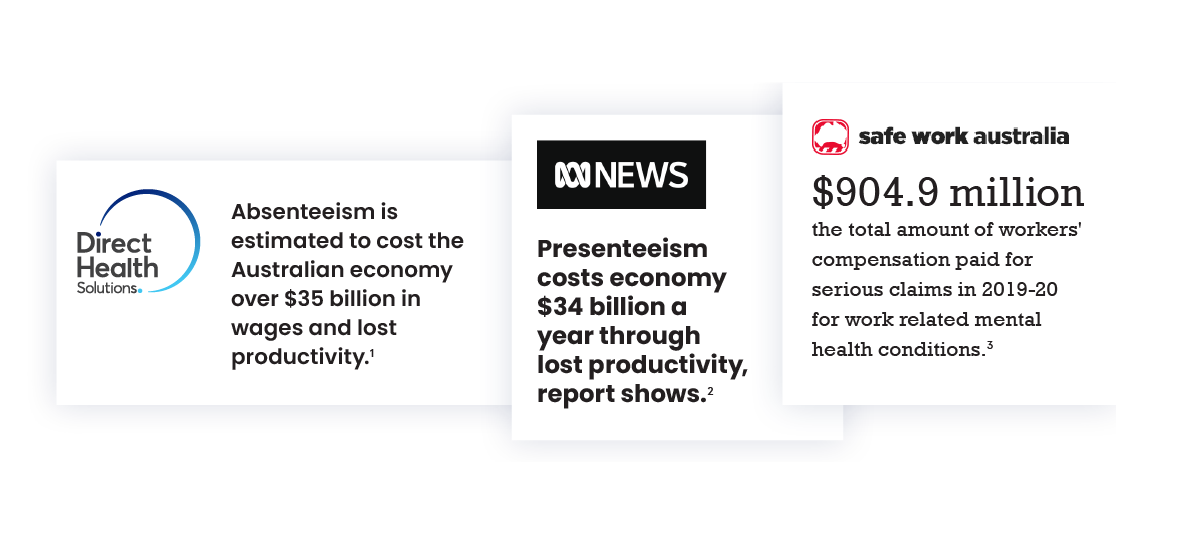
But, these figures only tell a fraction of the story.
Poor wellbeing can affect not only an employee’s workforce participation and productivity, but that of their colleagues, managers, family members, and close friends – which represents a substantial hidden cost to organisations – on top of the direct costs of absenteeism, presenteeism, and workers’ compensation for the impacted worker.
This hidden cost is called the ripple effect and it’s the untold story of lost productivity that reveals the true workplace cost of poor employee wellbeing.
What is a ripple effect?
A ripple effect is where one single action or event causes a spreading effect or series of consequences. It is a common metaphor in social science literature “to describe how our actions (or non-actions) reverberate throughout the physical and social world”.
Its most common analogy is the dropping of a pebble into a pond, which triggers concentric ripples across the surface as it disturbs an increasingly larger portion of the ecosystem.
COVID-19 pandemic: an example of a ripple effect
Short-term ripple effects
- >13.3 billion vaccinations
- >649 million infections
- >6.65 million deaths
- Exhausted healthcare workforce, who have been “feeling [overworked and] pressured not to take sick leave or mental health days”
- Unprecedented economic and psychological stress, due to border lockdowns, mandatory isolations, worker shortages, business closures, plane groundings, stretched healthcare funding, and catastrophic supply chain shortages. (Sources: Australian Bureau of Statistics, World Health Organization, United Nations, BMJ Open, Frontiers in Psychology)
Long-term ripple effects
- >11 million girls may not go back to school after the COVID-19 crisis
- Climate change investment redirected to pandemic causes
- Cancer referral delays have reversed up to 8 years of improvements in survival rates
- New risks have been created from exacerbations to inequality, mental health issues, age discrimination, lack of societal cohesion, a widening of the wealth gap, and rapid rollouts of new technologies (Sources: World Economic Forum, United Nations, Cancer Research UK, The British Medical Journal)
How can poor wellbeing cause a ripple effect in the workplace?
When an employee is healthy and happy, they are more likely to be motivated, collaborative, and productive at work. (Sources: Centers for Disease Control and Prevention, Society for Human Resource Management, The Wall Street Journal.)
Wellbeing “encompasses the health of the whole person – physical, mental, social and emotional” and “is most likely to flourish in a supportive and inclusive environment”. It is unique to each individual and the factors that cause one person to feel (and/or be) well or unwell might not have the same impact on another person – or at least not at that same point in time.
When an employee is not well, their poor wellbeing typically presents in the workplace as absenteeism, presenteeism, emotional contagion, and/or resignation.
What is emotional contagion?
According to researchers at Yale University, emotional contagion is the phenomenon where one group member’s mood can ripple out to affect other group members’ emotions, group dynamics, and individual thinking, attitudes, and behaviours.
Poor wellbeing could be due to a medical, mental health, social, emotional, safety, financial, and/or other concern. It is often due to a complex set of multiple intertwined concerns that can make a person feel down, sad, tired, ill, distracted, disconnected, unmotivated, negative, and unable to work to their full capacity – or worse, unable to work at all.
Poor employee wellbeing can cause a ripple effect in the workplace because it can reduce not only the productivity of one employee but many employees.
Why does poor employee wellbeing affect multiple workplaces?
As discussed, poor employee wellbeing can cause a ripple effect in the workplace because it can reduce not only the productivity of one employee but many employees. In part two we’ll illustrate how poor employee wellbeing can affect multiple workplaces – via family members and close friends of the impacted worker, as well as family and close friends of their colleagues and managers.
To illustrate, not only did 86 per cent of 2,000 surveyed workers in our October 2022 Annual Workforce Survey say they had felt burnt out in the previous 12 months, with one in three taking time off due to concerns about their mental wellbeing, but 14 per cent took time off due to concerns about the mental wellbeing of their friends and family, and 60 per cent juggled extra work duties when a colleague was absent.
These figures show that many employees are not well and it’s affecting those around them – including organisations, who are footing the bill for more than just the direct costs of the impacted worker at the primary workplace. These figures show that many employees are not well – and this is affecting those around them.

How does poor employee wellbeing affect their primary workplace?
When an employee is absent, not working at full capacity, or bringing negative energy to work due to poor wellbeing, it can cause a ripple effect in their primary workplace.
Some examples of how the ripple effect can spread and impact their workplace include:
Direct colleagues
- May need to miss lunch or stay late to complete the extra workload
- May become irritable, resentful, and exhausted from the additional work
- May have projects that suffer delays and/or miss important deadlines
- May feel overwhelmed or helpless about how to help a colleague appropriately
Indirect colleagues
- May have meetings cancelled and deliverables forgone from affected colleagues
- May feel unhappy about disharmony between their colleagues
- May get distracted and find their work begins to lose focus
- May start to feel annoyed, irritable, and unsatisfied with achievements
Managers
- May need to ask others to increase their work output, or shoulder it themselves
- May spend additional time on performance management, employee counselling, or searching for employee support resources
- May feel overwhelmed with the magnitude of the physical and psychological challenges of their team members
- May become frustrated and anxious, lose their motivation to work, and feel helpless if they lack the knowledge to help or respond
The organisation
- May lose revenue from reduced output or business opportunities
- May incur additional costs from higher-paid substitute workers, increased workers’ compensation premiums and/or higher outlays for employee support programs
- May see increased safety risks (both physical and psychological)
- May have their positive team culture impacted
- May experience increased employee attrition
How does poor employee wellbeing affect a secondary workplace?
In addition, poor employee wellbeing can affect secondary workplaces because it can have a multiplier effect across the workplaces of family members and close friends.
This is because:
- It’s difficult for anyone to perform at their full potential when they are worried about, caring for, or taking on extra duties for someone else; and
- Our work lives and personal lives are inextricably linked, wrote Professor Rosabeth Moss Kanter from Harvard Business School, who detailed “the myth of separate worlds”.
Examples of how the ripple effect can impact other workplaces include:
Family and close friends of the employee
- May be stressed and distracted at work because they are worried about their loved one’s health and job security
- May be tired or irritated at work (or need to skip work) because they are juggling extra physical, emotional, and financial responsibilities at home
- Their organisations may incur additional costs, safety risks, customer complaints, attrition, lost revenue from reduced output or missed business opportunities, and more
Family and close friends of the employee’s colleagues and managers
- May arrive late at their workplaces if they could not leave home before their loved ones returned from their extra work duties
- May then arrive at work stressed and angry, which could affect both productivity and team harmony
- Their organisations may incur additional costs, safety risks, customer complaints, attrition, lost revenue from reduced output or missed business opportunities, and more
Multiple workplaces impact | Case study: Luke
Luke is an employee with poor wellbeing.
He is often absent from work.
Luke works with Zara, Tom, Miguel, Ana, Ben and Joanna.
He lives with his friends Yi-jun and Hugo.
His mother Evelyn lives across town.
Luke’s poor wellbeing affects everyone in his immediate ecosystem.
It also affects Zara’s partner Kazuko and their children, plus Sally, the company’s People and Culture consultant.
To see how this ripple effect impacts Luke’s work and personal ecosystem, we invite you to download our report to see the below visual more clearly.
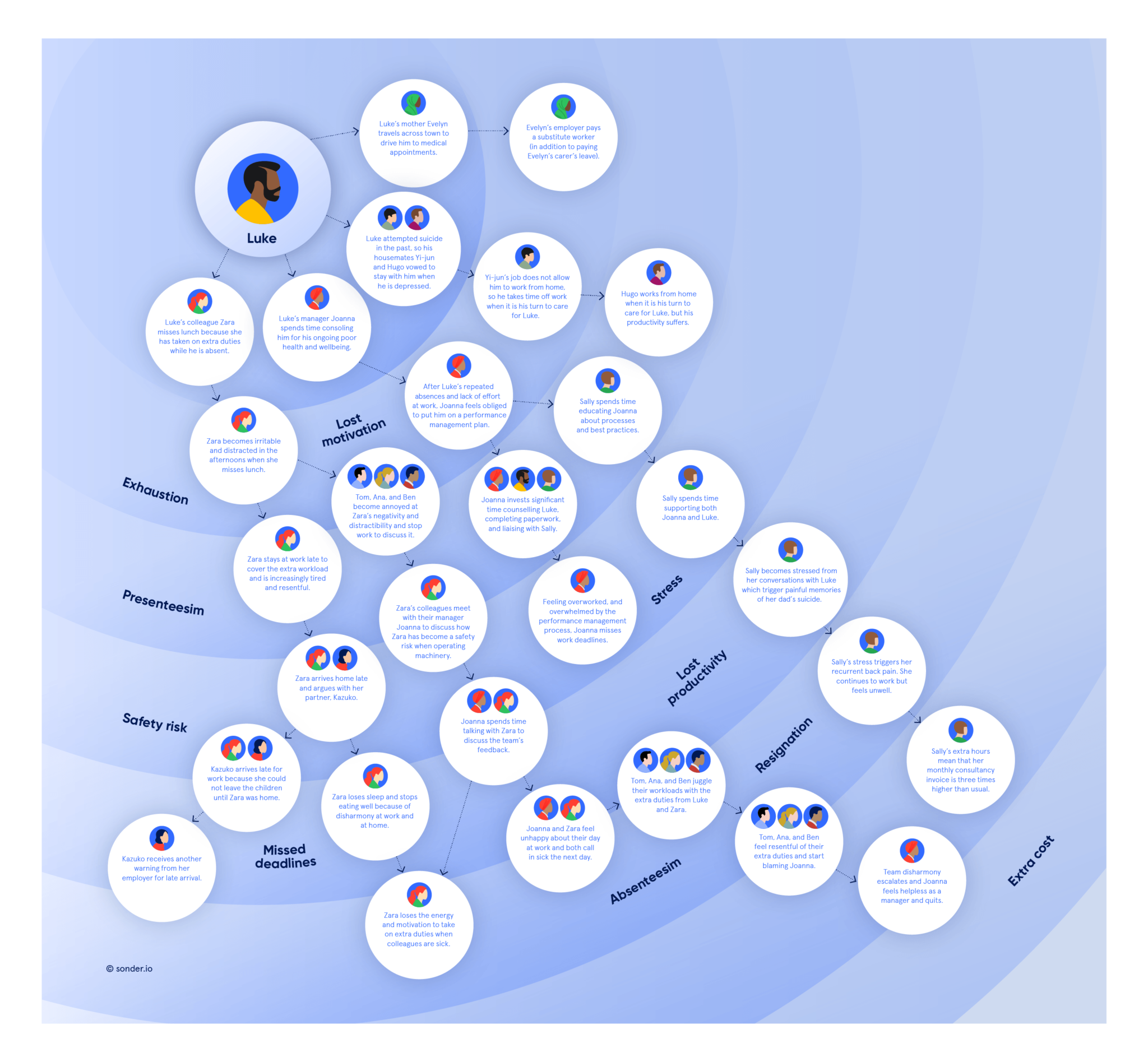
What is the ripple effect costing organisations?
Organisations are leaking millions of dollars each year in absenteeism, presenteeism, workers’ compensation, employee turnover, and the ripple effect of lost productivity from colleagues and family members – all because many employees are not well. What is this costing organisations and what can they do to minimise the impact?
A discussion such as this is important because the more that organisations can recognise, track, quantify, and minimise the ripple effect of poor employee wellbeing, the more they can keep their people safe, well, engaged, and productive – so they can enjoy their work and perform at their best.
Sources: Direct Health Solutions, Australian Broadcasting Commission, The Centre for International Economics, Medibank, Safe Work Australia, Sonder
Direct costs
Most organisations track and quantify the direct costs of poor employee wellbeing in their workplace. These direct costs are generally calculated by taking the amount of time lost (in hours) and multiplying it by the hourly wage of the worker (although this approach fails to take into account the marginal value of the worker against their role – meaning, a worker holds more value to the company than only salary input).
Direct costs are typically calculated via lagging indicators such as:
- Absenteeism;
- Workers’ compensation;
- Lost time injury frequency rates (LTIFR);
- Return to work rates;
- Attrition; and
- Presenteeism.
Note: Most organisations do not track and quantify presenteeism (i.e. being at work despite being unwell), despite that it can cause “reduced work performance” and “contribute substantially to productivity costs for employers”, concluded researchers Strömberg, Aboagye, Hagberg, Bergstrom, and Lohela-Karlsson, from the Karolinska Institute in Sweden.
Sources: ScienceDirect, Journal of Organizational Behavior
Indirect costs
Few organisations acknowledge, track, and quantify their indirect costs of poor employee wellbeing – despite the reality that these usually outweigh the direct costs.
Indirect costs are particularly important where a reduction in worker performance affects the productivity output not only of the worker but also of coworkers and team leaders. Job-specific factors related to an impacted worker, and their coworkers, can make the productivity costs to employers significantly higher than direct wages.
Indirect costs typically include:
- Time taken by colleagues and managers to help an employee with poor wellbeing;
- Reduced morale and productivity from colleagues who regularly take on extra duties;
- Time taken to find substitute workers;
- Additional payments to substitute workers;
- Reduced quality of individual and/or team output;
- Risk of burnout and attrition for colleagues taking on extra duties; and
- Lost revenue opportunities where time-sensitive deadlines were missed.
Sources: ScienceDirect, Journal of Organizational Behavior
Wage multipliers
One way of calculating the ripple effect across a team or organisation is through wage multipliers, where the total productivity losses are calculated as a factor of the impacted employee’s wage.
Total productivity losses from absenteeism can range between 1.4 to 2.8 times the value of the impacted worker’s wage. The variation depends on the employee’s role and industry, the ease of finding a substitute for that worker, the degree of time sensitivity of output, and the degree to which output is based on teamwork.
Multiple studies such as Strömberg et. al. have identified an average wage multiplier for absenteeism of 1.97 (and 1.70 for presenteeism). Some occupations have higher wage multipliers (e.g. transport workers, couriers, engineers, and information technology workers). Others have lower wage multipliers (e.g. chefs, waiters, and workers in heavy industry and manufacturing).
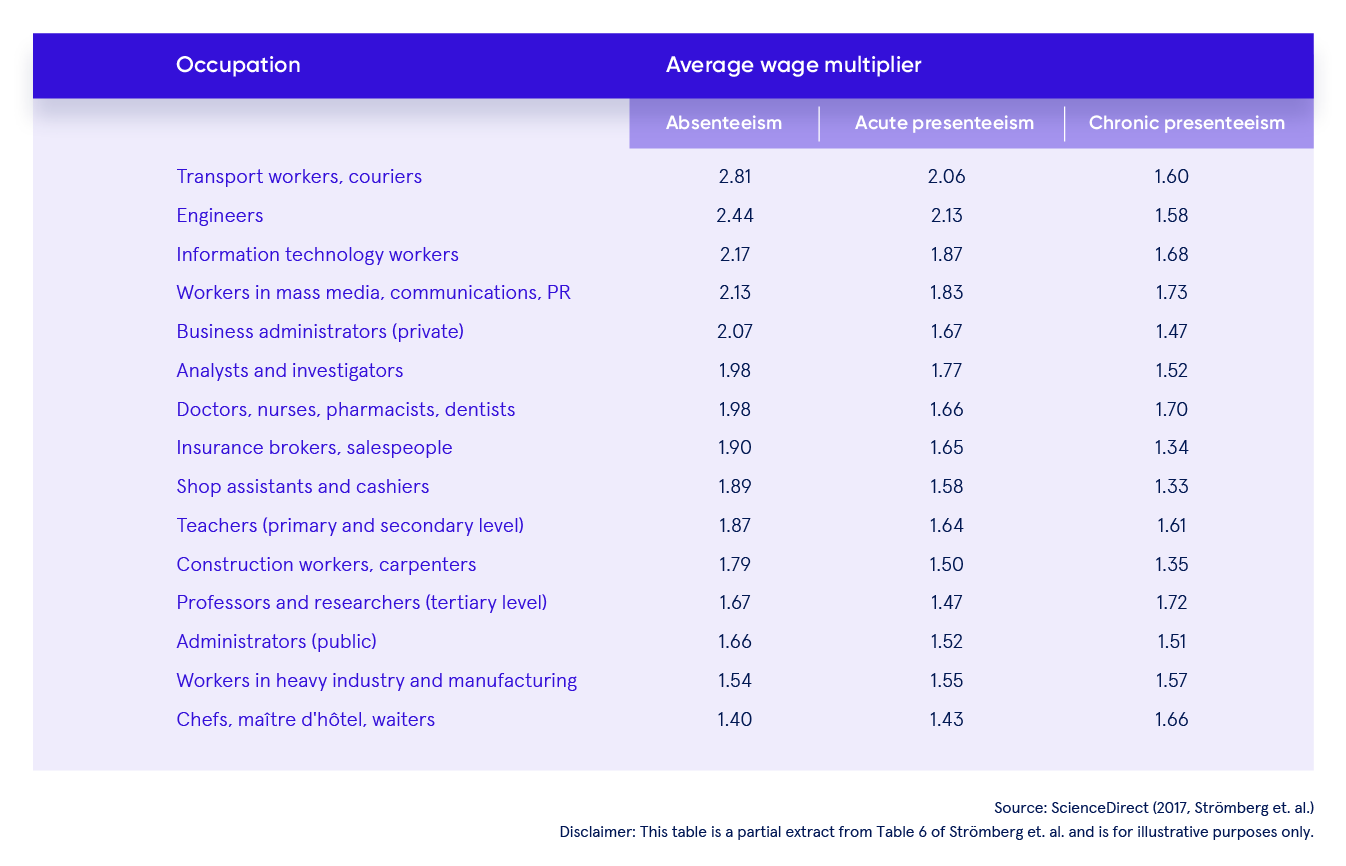
Cost of poor wellbeing | Case study: Nadira
Nadira (fictional character) was a dedicated frontline worker at Superb Stores. She had been part of the team for 20 years, was loved by customers, and often won the company’s ‘employee of the month’ award.
Unfortunately, on one of Nadira’s night shifts, her wrist was broken during a physical attack by an intoxicated customer. As a result of the assault, she also developed serious mental health concerns.
Scenario
- Nadira took three sick leave days to recover and to visit the hospital for treatment. Her colleagues picked up extra work duties to cover her absences.
- Absenteeism = $1,225.
- After a while, the goodwill of her frontline colleagues wore off as they began to feel overworked and burnt out. Nadira’s direct manager spent three hours discussing Nadira’s case with their People and Culture manager.
- Management time = $219.
- When Nadira returned to work full-time, she complained about pain in her wrist, but she kept her post-incident psychological struggles to herself. Her manager transferred her to light duties in the back office. Soon after, her upbeat demeanour changed. Nadira did not understand what she was experiencing, so she spent five work hours researching her symptoms.
- Presenteeism = $237.
- Nadira’s back-office manager noticed she was frequently distracted at work, and she was fielding complaints from Nadira’s new colleagues. Her manager spent one hour each week for four weeks counselling Nadira.
- Management time = $260.
- Within months, Nadira regressed into a depressed state. She was frequently sad and absent from work on sick leave. Her back-office colleagues were given extra duties to cover for her. This negatively affected morale and output.
- Absenteeism = $3,674.
- Team tension grew, and, not knowing what else to do, Nadira’s back-office manager filled in all of the paperwork to report her to senior management, gave her a formal warning, and put her on a performance plan.
- Management time = $200.
- One week later, Nadira resigned.
- Recruitment, training, and management time = $19,562.
- Total lost productivity cost = $25,377.
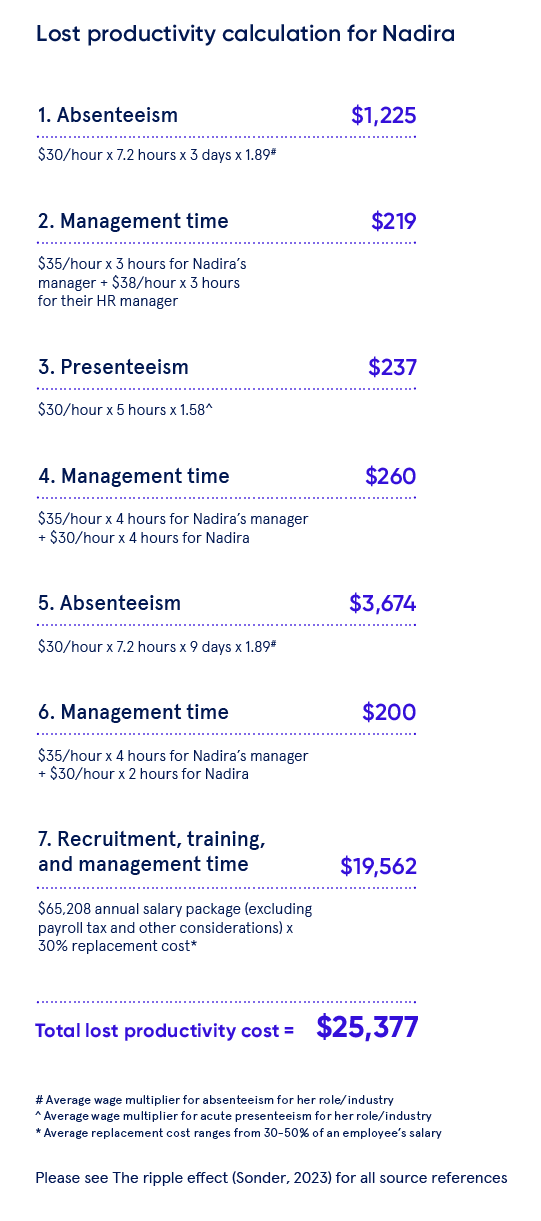
How can organisations take to minimise the ripple effects of poor employee wellbeing?
We’ve now defined and covered what the ripple effects of poor employee wellbeing are – in addition to acknowledging, tracking, and better quantifying the hidden cost of lost productivity, how can organisations enact positive change?
Organisations can make a meaningful difference by: (a) helping to improve the wellbeing of their employees; and (b) helping to improve the wellbeing of the family members and close friends around them. We’re going to walk you through the how, let’s get started.
Strategy 1: Help improve the wellbeing of employees
“Workers’ wellbeing is a key factor in determining an organisation’s long-term effectiveness. Many studies show a direct link between productivity levels and the general health and wellbeing of the workforce”, says the International Labour Organization (ILO).
Yet, many employees are not well, which is causing a ripple effect across workplaces and costing billions of dollars each year in lost workforce participation and productivity.
Suggestions for how to improve the wellbeing of employees include:
Cultivate a culture of wellbeing
- Encourage leaders to advocate for wellbeing, challenge wellbeing myths, approve funding, and personally participate in wellbeing initiatives.
- Help managers promote positive wellbeing, understand the impact of poor wellbeing, and recognise early warning signs.
- Teach managers how to best support their teams.
- Build a culture that understands health complexity, as wellbeing is very personal and health conditions affect people differently.
Create a safe and healthy workplace
- Minimise physical and psychological health and safety risks (see ISO 45001 and ISO 45003).
- Design jobs appropriately, with consideration for personal control, autonomy, decision-making, and change management.
- Implement formal policies and user-friendly processes that provide safe and healthy workplaces.
Implement meaningful support systems
- Redesign workplace wellbeing programs to ensure employees have 24/7 access to safety, medical, and mental health care.
- Offer psychological first aid (PFA) after critical events, rather than psychological debriefing.
- Prioritise prevention and early intervention via proactive notifications and early-warning data.
- Improve contingency planning to reduce the burden when covering for colleagues.
- Offer personalised and comprehensive support for employees returning to work after absences.
Strategy 2: Help improve the wellbeing of family members and close friends
Old-style leaders argue it is not their responsibility to improve the wellbeing of family members (and friends). The best leaders take a more active care approach. They recognise that an employee’s family (and friends) form an essential first line of support that can reduce the cost and impact of the ripple effect.
Suggestions for how to improve the wellbeing of family members and close friends include:
Broaden social invitations
- Invite family members and close friends to work tours and social activities, to help build empathy, social connection, and stronger relationships with colleagues.
Extend meaningful support
- Provide 24/7 access to medical, mental health, and safety support to family members so they can access care when they need it.
- Consider enhancing employee leave policies (e.g. time in lieu, parental leave, carer’s leave, childcare assistance, financial assistance, transport assistance, and domestic and family violence leave).
Strategy 3: Scrap a traditional EAP offering for something more effective
Fewer than 5% of employees use traditional EAP services. The reality is that traditional EAPs are no longer enough to support the evolving needs of today’s workforce. With low engagement rates and rising costs of absenteeism and presenteeism, it’s time to embrace a better approach to employee wellbeing.
Some just treat symptoms, we treat the whole person
Your team’s health, safety and wellbeing issues don’t exist in isolation. That’s why our medically accredited employee care platform gets to the root cause of your people’s challenges, from burns to burnout and everything in between. Sonder also boasts a 40% uptake rate, making us a whole lot more effective than outdated EAPs.
Discover how Sonder can help you strengthen your wellbeing offering
Sonder provides comprehensive support for companies looking to position themselves as an employer of choice.
Our platform provides employees with 24/7 support with personal wellbeing assessments, self-serve wellbeing resources, medical advice, safety support and a live chat with registered health professionals. All of this ensures that holistic, preventative employee care is at the forefront of your EVP.
Get in touch with Sonder today to chat about how our platform can benefit your organisation and help you attract and retain talent.
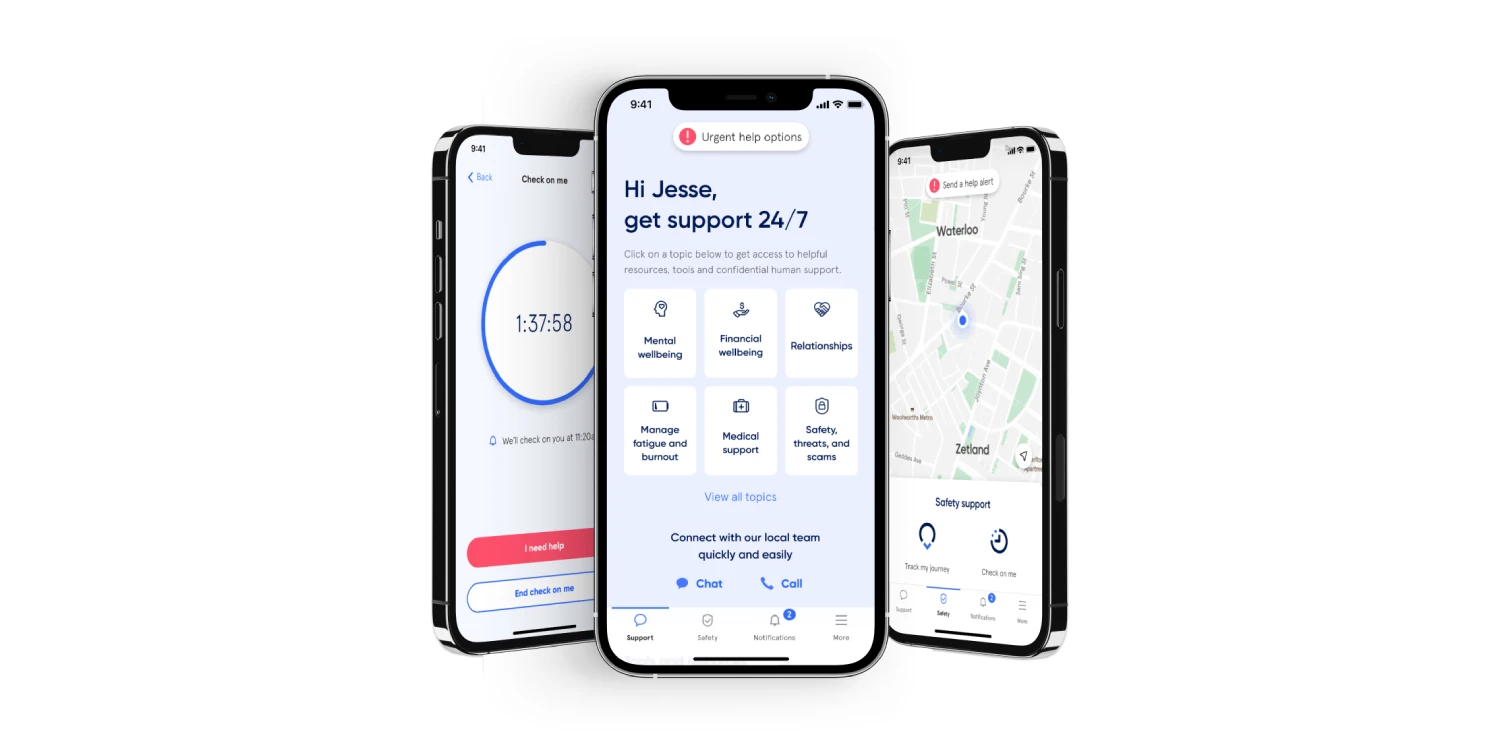
About Sonder
Sonder is a technology company that helps organisations improve the wellbeing of their people so they perform at their best. Our mobile app provides immediate, 24/7 support from a team of safety, medical, and mental health professionals – plus onsite help for time-sensitive scenarios. Accredited by the Australian Council on Healthcare Standards (ACHS), our platform gives leaders the insights they need to act on tomorrow’s wellbeing challenges today.



